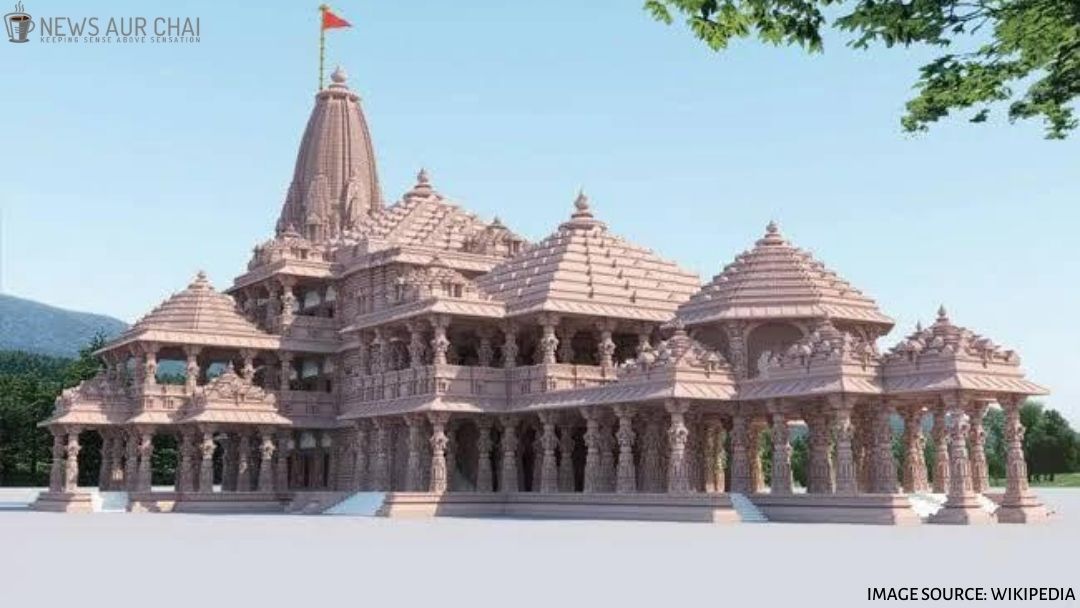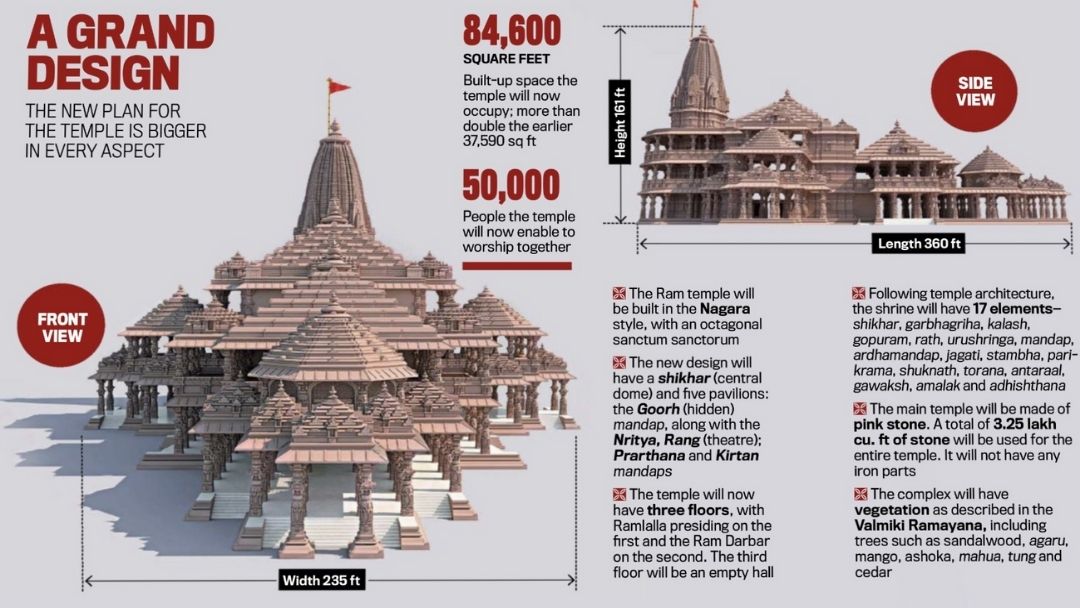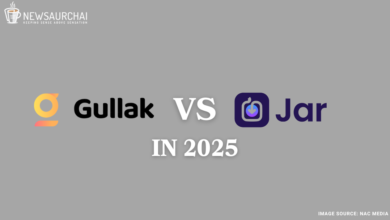
The construction of the Ram Mandir at Ayodhya is all set to begin this month. Shri Ram Janmabhoomi Mandir Tirtha Kshetra, formed under the directions of the Supreme Court to facilitate the process, has been convening throughout July to fix actionable dates for the construction work to commence.
With the date of the ‘Bhumi Pujan’ scheduled for August 5, city of Ayodhya underwent a makeover of being painted in the auspicious colour of yellow. Prime Minister Narendra Modi will be presiding over the event on Wednesday.
https://twitter.com/ShobhaBJP/status/1290582460275634177
The Babri Masjid-Ram Janmabhoomi dispute originates with the construction of a mosque built by Babur in a land which Hindus have forever claimed to be the site of a Ram Temple demolished by Babur’s men who allegedly built the mosque over the Temple’s ruins. Ayodhya also marks the birthplace of Lord Ram.
पीएम श्री @narendramodi श्रीराम जन्मभूमि मंदिर का भूमिपूजन करते हुए। #JaiShriRam pic.twitter.com/wgVIzUsBcW
— BJP (@BJP4India) August 5, 2020
Here is a timeline of the significant dates of the historical conflict between the construction of Ram Mandir vs Babri Masjid.
Chronology of Events:
Following a decades-long land dispute, the Supreme Court granted the entire 2.77 acres of disputed land in Ayodhya to deity Ram Lalla for building his Temple on November 9, 2019, in a historic judgment.
- 1528 – Mir Baqi, Mughal Emperor Babur’s commander, builds Babri Masjid.

- 1859 – British Officials divide the areas of worship by erecting a fence — the inner court for the Muslims and the outer court to be used by Hindus.
- 1885 – Mahant Raghubir Das’ plea to build canopy outside disputed structure gets rejected in the Faizabad district court.
- 1949 – Idols of Ram Lalla get placed under the central dome. Muslims protest and both parties file civil suits, following which the government locks the gates, terming the premises to be disputed.
- 1950 – Gopal Simla Visharad and Ramchandra Das file suits in the Faizabad district court seeking rights to worship the idols of Ram Lalla.
- 1959 – Nirmohi Akhara enters the fray and files suit claiming possession rights over the land.
- December 18, 1961 – UP Sunni Waqf Board files suit seeking possession of the site.
- February 1, 1986 – District Court orders the government to open up the site to Hindu worshippers on the plea of Hari Shanker Dubey. Muslims set up Babri Masjid Action Committee. Rajiv Gandhi was then Prime Minister.
- 1989 – Deoki Nandan Agarwala, a former judge of the Allahabad High Court, files a new suit representing Bhagwan Shri Ramlalla Virajman at Sri Ram Janma Bhoomi Ayodhya for declaration of the title and possession in its favour. Thus, BJP officially joins the movement.
- August 14, 1989 – Allahabad High Court issues order to maintain status quo at the disputed structure.
- November 1989 – VHP performs ‘Shilanyas’ ceremony in Ayodhya, establishing the first stone of the planned Ram Mandir.
- September 25, 1990 – BJP leader Lal Krishna Advani launches Rath Yatra from Somnath in Gujarat to Ayodhya. During the yatra, Advani gets arrested in Bihar.
- November 1990 – Several Karsevaks under Vishva Hindu Parishad (VHP) leaders get killed in the clash with Uttar Pradesh police in Ayodhya.
- June 1991 – Kalyan Singh of BJP becomes Chief Minister of UP and acquires 2.77 acres of land around the disputed area.
- December 6, 1992 – Turning Point of the entire dispute, as Karsevaks, supporters of the VHP, the Shiv Sena and BJP demolish the Babri Masjid, prompting communal riots between Hindus and Muslims. More than 2000 people die.
- April 3, 1993 – Center passes ‘Acquisition of Certain Area at Ayodhya Act’ to acquire land in the disputed area. Several petitions filed challenging the act, including one filed by Ismail Faruqui in Allahabad High Court.
- October 24, 1994 – Supreme Court says in the historic Ismail Faruqui case that the mosque was not integral to Islam.
- April 2002 – Hearings begin in Allahabad High Court to determine ownership of disputed land.
- March 13, 2003 – Supreme Court rules out religious activities of any nature at the acquired land in the Aslam alias Bhure case.
- September 30, 2010 – Allahabad High Court verdict states in a 2:1 majority that the 2.77 acres of disputed land would be partitioned between Sunni Waqf Board, Nirmohi Akhara and Ram Lalla.
- May 9, 2011- Supreme Court stays the verdict of the Allahabad HC and says to maintain the status quo after petitions were filed against it.
- March 21, 2017- Former Chief Justice of India Jagdish Singh Khehar suggests out-of-court settlement among rival parties.
- August 7, 2017- Supreme Court constitutes a three-judge bench for hearing the pleas challenging Allahabad High Court’s verdict. The Uttar Pradesh (UP) Shia Central Waqf Board tells that mosque could be built at a reasonable distance from the disputed land in a Muslim-dominated area.
- November 20, 2017- UP Shia Central Waqf Board tells Supreme Court that Temple can be built in Ayodhya and mosque in Lucknow.
- December 1, 2017- 32 civil rights activists file pleas challenging Allahabad HC’s verdict.
- February 8, 2018- Civil appeal hearings start at Supreme Court.
- March 14, 2018 – Supreme Court rejects all interim pleas trying to intervene in the case as other parties.
- January 8, 2019 – Apex Court sets up a five-judge Constitution bench headed by former Supreme Court Chief Justice Ranjan Gogoi for the case hearing. Justices SA Bobde, NV Ramana, UU Lalit and DY Chandrachud comprise the bench.
- January 25, 2019 – The 5-member Constitution bench gets reconstituted with the inclusion of Justices Ashok Bhushan and SA Nazeer in place of Justices NV Ramana and UU Lalit.
- March 8, 2019 – Supreme Court refers the dispute for meditation of land title dispute by a panel headed by former S judge Fakkir Mohamed Ibrahim Kalifulla and comprising of spiritual leader Sri Sri Ravi Shankar and senior advocate Sriram Panchu.
- August 2, 2019 – Supreme Court declares that meditation has failed according to the report submitted by the Chairman of the committee. Day-to-day hearings commence from August 6.
- October 16, 2019 – Supreme Court concludes hearing and reserves order.
- November 9, 2019 – Supreme Court hands over the entire 2.77 acres of land to Ram Lalla and orders the setting up of a trust to facilitate the construction of a temple at Ayodhya. It also directs the Centre and UP Government to allot alternative 5-acre land to the Muslims in Ayodhya at a prominent place to build a mosque.
- July 15, 2020 – Former DG of the Border Security Force, KK Sharma arrives at Ayodhya after becoming Ramjanmabhoomi Security Advisor to inspect the complex and hold meetings with concerned stakeholders.
- July 16, 2020 – Nripendra Mishra, Chairman of the Ram Mandir Nirman Samiti, conducts his first meeting with administrative authorities of the district and trustees of Shri Ram Janmabhoomi Mandir Tirtha Kshetra.
- July 17, 2020 – Discussions continue regarding the architecture of the Temple. UP Chief Minister Yogi Adityanath prepares a roadmap for the complete development of Ayodhya ahead of ‘Bhoomi Pujan’.
- August 5, 2020 – Scheduled date of the ‘Bhumi Pujan’.
Countdown begins in Ayodhya. Our Ram Lalla, An emperor under who's rule every1 irrespective of cast creed were happiest. N 2 this day we utter "Sarve Janah Sukhinobhavantu"
Prabhu Raja Ramachandra Maharaj ki Jai!#सबके_राम #RamMandirAyodhya #श्री राम #JaiShreeRam #ProfileForRam pic.twitter.com/ey5SefmsjY
— Srinidhi Ananth (@ImSrinidhi) August 4, 2020
The ceremonies at Ayodhya began from Tuesday with the worship of the presiding deity of the city Lord Hanuman, continuous chants of Akhand Ramayan in all local temples, Deepotsava by lighting of oil lamps in houses, temples and the Sarayu River on the night of August 4-5.
Saints, seers from several spiritual traditions all over India, BJP and RSS leaders, office bearers and dignitaries of the VHP would be present. Strict social distancing regulations have been devised. As per officials, a 22.60 kg brick made of pure silver would be used for ‘Bhumi Pujan’. After this program, the construction work will begin in full swing and is expected to complete within six months to one year.
Current Updates:
Prime Minister Narendra Modi arrived in Lucknow around 10:30 am and proceeded to ‘Shree Ram Janmabhoomi’. Around 11:30 am PM Modi helicopter lands at Saket College Helipad in Ayodhya. UP CM Yogi Adityanath welcomes the Prime Minister as they head towards Hanuman Garhi temple. Amid COVID-19 pandemic only PM Modi, Yogi Adityanath and 175 people who figure in a select guest list of seers and politicians will attend the ceremony.
The Press Information Burea of India PM Modi will be planting a Parijat (Indian Jasmine) sapling and subsequently perform Bhoomi Pujan. Furthermore, Prime Minister will unveil a plaque to mark the laying of Foundation Stone and also release Commemorative Postage Stamp on ‘Shree Ram Janmabhoomi Mandir’.
Prior to the Bhumi Pujan the Prime Minister and CM Adityanath took part in ‘pooja’ and ‘darshan’ at Hanumangarhi temple.
According to the reports, the Priest at Ram Temple ‘Bhumi Pujan’ said: “Nine bricks are kept here. These were sent by devotees of Lord Ram from around the world in 1989. There are 2 lakh 75 thousand such bricks out of which 100 bricks with ‘Jai Shri Ram’ engraving have been taken.”
The ‘Bhumi Pujan’ of the grand temple in Ayodhya, at a spot where devotees believe that Lord Ram was born, is said to take place at 12:40 pm, which is the ‘muhurat’ for the foundation stone laying ceremony.

After the foundation stone laying ceremony was concluded, a stage event will follow shortly. Alongside Prime Minister Narendra Modi, Rashtriya Swayamsevak Sangh Chief Mohan Bhagwat, Uttar Pradesh Chief Minister Yogi Adityanath, Governor Anandiben Patel and President of Ram Mandir Trust Nitya Gopal Das will be present on the stage for the event.





